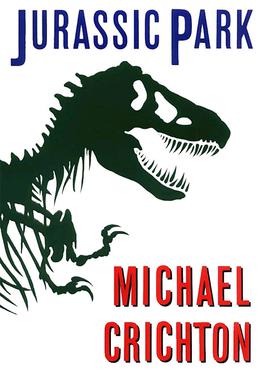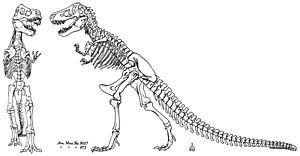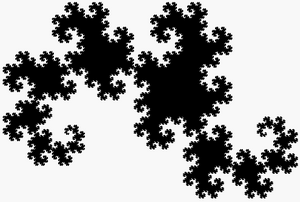Jurassic Park (novel) facts for kids

First edition cover
|
|
| Author | Michael Crichton |
|---|---|
| Cover artist | Chip Kidd |
| Country | United States |
| Language | English |
| Genre | Science fiction novel |
| Publisher | Alfred A. Knopf |
|
Publication date
|
November 20, 1990 |
| Media type | Print (Hardcover and Paperback) |
| Pages | 448 |
| ISBN | 0-394-58816-9 |
| OCLC | 22511027 |
| 813/.54 20 | |
| LC Class | PS3553.R48 J87 1990 |
| Followed by | The Lost World |
Jurassic Park is a 1990 science fiction novel written by Michael Crichton. A cautionary tale about genetic engineering, it presents the collapse of an amusement park showcasing genetically re-created dinosaurs to illustrate the mathematical concept of chaos theory and its real world implications. A sequel titled The Lost World, also written by Crichton, was published in 1995. In 1997, both novels were re-published as a single book titled Michael Crichton's Jurassic World.
In 1993, Steven Spielberg adapted the book into the blockbuster film Jurassic Park. The book's sequel, The Lost World, was also adapted by Spielberg into a film in 1997. A third film, directed by Joe Johnston and released in 2001, drew several elements, themes, and scenes from both books that were ultimately not utilized in either of the previous films, such as the aviary and boat scenes.
The novel began as a screenplay Crichton wrote in 1983, about a graduate student who recreates a dinosaur. Eventually, given his reasoning that genetic research is expensive and "there is no pressing need to create a dinosaur", Crichton concluded that it would emerge from a "desire to entertain", leading to a wildlife park of extinct animals. Originally, the story was told from the point of view of a child, but Crichton changed it as everyone who read the draft felt it would be better if told by an adult.
Plot summary
In 1989, a series of strange animal attacks occur in Costa Rica, including a worker severely injured on a mysterious construction project on the nearby island of Isla Nublar. One of the species behind the attacks is identified as a Procompsognathus. Paleontologist Alan Grant and his paleobotanist graduate student, Ellie Sattler, are contacted to confirm the identification, but are abruptly whisked away by billionaire John Hammond — founder and chief executive officer of International Genetic Technologies, or InGen — for a weekend visit to a "biological preserve" he has established on Isla Nublar.
The preserve is revealed to be Jurassic Park, a theme park showcasing cloned dinosaurs. The animals have been recreated using damaged dinosaur DNA found in blood inside of gnats, ticks, and mosquitoes fossilized and preserved in amber. Gaps in the genetic code have been filled in with "compatible" reptilian, avian, or amphibian DNA. To control the population, all specimens on the island are lysine-deficient and X-Ray sterilized females.
Recent incidents in the park have spooked Hammond's investors. To placate them, Hammond uses Grant and Sattler as fresh consultants. They stand in counterbalance to a famous mathematician and chaos theorist, Ian Malcolm, and a lawyer representing the investors, Donald Gennaro, who are pessimistic about the park's prospects. Malcolm, having been consulted before the park's creation, is especially emphatic in his prediction that the park will collapse, as it is an unsustainable simple structure bluntly forced upon a complex system with too many unpredictable variables. Hammond also brings along his grandchildren, Tim and Alexis "Lex" Murphy, who join the tour group. The park's staff include engineer John Arnold, biotechnologist Henry Wu, game warden Robert Muldoon, public relations manager Ed Regis and veterinarian Gerry Harding. While touring the park, Grant finds a Velociraptor eggshell, seemingly proving Malcolm's earlier assertion that the dinosaurs have somehow been breeding against the geneticists' design.
Meanwhile, the disgruntled chief programmer of Jurassic Park's controlling software, Dennis Nedry, attempts corporate espionage for Lewis Dodgson, a geneticist and agent of InGen's archrival, Biosyn. By activating a backdoor he wrote into the park's computer system, Nedry shuts down its security systems and steals frozen embryos for each of the park's fifteen species in an attempt to smuggle them out of the park. However, during Nedry's escape he loses his bearings due to a sudden tropical storm, and is killed by a Dilophosaurus. Without Nedry to reactivate the park's security, the electrified fences remain off and all the dinosaurs escape. The park's adult Tyrannosaurus attacks the guests on tour, with a juvenile T. rex killing Regis. In the aftermath, Grant and the children become lost in the park. Malcolm is gravely injured during the incident, but is found by Gennaro and Muldoon, and spends the remainder of the novel slowly dying as – between lucid lectures and rants – he tries to help the others understand their predicament and survive.
The park's staff manage to temporarily get the park largely back in order, restoring the computer system by shutting down and restarting the power. When trying to restore the park to working order, they fail to notice that the system has been running on auxiliary power since the restart; this power soon runs out, shutting the park down a second time. The park's intelligent and aggressive Velociraptors escape their enclosure, and kill Arnold and Wu. Meanwhile, Grant and the children slowly make their way back to the Visitor Center by rafting down the jungle river, carrying news that several young raptors were on board the island's supply ship when it departed for the mainland. After the three return to the visitor's center, they are contacted by the others, who instruct Grant to switch on the park's generators. Tim is then able to reactivate the park's main power, allowing Gennaro to force the supply ship to return.
Grant, Sattler, Muldoon, and Gennaro find the wild raptor nests and compare hatched eggs with the island's revised population tally, realizing the animals are leaving the island in an attempt at migration. Meanwhile, Hammond, taking a walk and contemplating building a new park improving on his previous mistakes, hears a T. rex roar and, startled, falls down a hill, where he is eaten by a pack of Procompsognathus. Grant deduces that using frog DNA to fill gaps in the dinosaurs' genetic code enabled a measure of dichogamy, in which some of the female animals changed into males in response to the same-sex environment. The computer tally failed to include newborn animals, having been programmed to stop counting once the assumed correct total number of animals had been found.
The survivors are rescued by the Costa Rican Air Force, which declare the island hazardous and unsafe, and proceed to raze the island with napalm. Survivors of the incident are indefinitely detained by the United States and Costa Rican governments at a hotel. Weeks later, Grant is visited by Dr. Martin Guitierrez, an American doctor who lives in Costa Rica. Guitierrez informs Grant that an unknown pack of animals has been migrating through the Costa Rican jungle, eating lysine-rich crops and chickens, indicating the dinosaurs may still exist in the wild.
Prehistoric Animals Featured In Novel
- Apatosaurus (Camarasaurus in some editions)
- Cearadactylus
- Microceratops (Callovosaurus in some editions)
Themes

Jurassic Park critiques the dystopian potentialities of science. There are Christian undertones in the skepticism of Ian Malcolm, though Christian terminology and imagery is never used. Malcolm is the conscience that reminds John Hammond of the sacrilegious path that has been taken. The final condition of the park is epitomized by the word "hell", which highlights the nature of Hammond's sacrilegious attempt.
Michael Crichton's novel is another version of Mary Shelley's 1818 novel Frankenstein; or, The Modern Prometheus tale where humanity creates without knowing. Henry Wu is unable to name the things that he creates, which alludes to Victor Frankenstein not knowing what to call his flawed imitation of God's creative powers. The immorality of these actions lead to human destruction, echoing Frankenstein.
Similar to how his other novels represent science and technology as both hazardous and life-changing, Michael Crichton's novel highlights the hypocrisy and superiority complex of the scientific community that inspired John Hammond to re-create dinosaurs and treat them as commodities, which only lead to catastrophe. The similar fears of atomic power from the Cold War are adapted by Michael Crichton onto the anxieties evoked by genetic manipulation.
See also
 In Spanish: Parque Jurásico (novela) para niños
In Spanish: Parque Jurásico (novela) para niños


